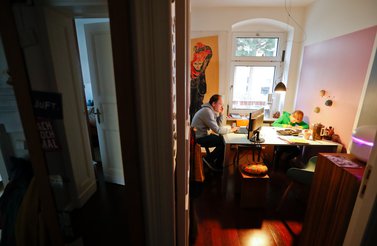The outbreak of COVID-19 is sweeping across the planet. Households are quarantined, schools are shut down and new “shelter in place” announcements are issued almost daily.
In the midst of it all, one California-based technology firm, Zoom Video Communications Inc., is becoming a leading tool for remote communications.
Even before COVID-19, Zoom was already well-known in certain business and podcasting circles as a go-to video conferencing technology company with a high-flying stock price that offered a free 40-minute group meeting video chat service.
But now, with much of the global workforce instructed to work from home, the technology operation run by chief executive officer Eric Yuan is becoming a household name — not just with corporate workforces, but with schools as well. Earlier this month, it announced free Zoom group video chats for all students from kindergarten to Grade 12 in affected schools in the United States, Japan and Italy. That move is likely to help make the service a household name among school systems as well, many of which are employing the service to help facilitate remote learning.
“A whole new generation of business and schooling behaviour is adjusting here,” said Ryan Koontz, senior research analyst at Rosenblatt Securities in New York. “Zoom is in the right place at the right time. It has some compelling advantages in the space. Users don’t even have to download the app; they can use a browser.”
The uptick in Zoom application downloads is not surprising as employees seek to communicate with each other from home. According to Apptopia, a mobile intelligence firm, on March 16 alone, there were 201,774 downloads of the Zoom app in the United States, and 693,515 downloads globally. Zoom’s download numbers have been steadily rising worldwide daily throughout March.
However, the company’s major growth in users amidst the coronavirus outbreak has raised some serious privacy and security concerns. New York’s attorney general is investigating the company over worries that hackers can get “surreptitious access to consumer webcams.”
One key concern involves so-called Zoombombing, where hackers take over Zoom video conferences to display pornographic or racist images.
Even so, Zoom and rival Cisco Systems Inc.’s Webex are the dominant players in the video conferencing space — both are poised to capitalize on the new home-working realities. However, Koontz argued that Zoom is becoming a major threat to Cisco. Other smaller rivals exist too, including BlueJeans, a privately owned video conferencing and screen-sharing service that stands to benefit as well.
Beyond video conferencing firms, other online technology companies are also experiencing an uptick in usage, as schools adjust to the new economic realities. D2L, a Waterloo, Ontario-based online education platform company, is experiencing significant growth in the use of its services.
“We’ve seen about a two-times increase and we expect that to go to five or 10 times in the not too distant future in terms of learners making the shift to a fully online education,” said John Baker, founder of D2L, owner of the Brightspace learning management platform.
According to Apptopia, Brightspace Pulse, D2L’s mobile app for students, saw a big spike in worldwide users in January, with numerous days of more than 100,000 downloads since then.
D2L’s platform allows for online assignments, quizzes and teacher support. Its platform is available in 148 countries, with nearly 2,000 clients globally, including both companies and educational institutions, slightly more than half of which are in the United States and Canada. Baker notes that Brightspace is approaching one million active users on its app, but it has tens of millions of users globally for its platform, which does not need an app to function.
“Teachers can create content, activities, post assignments and have conversations with students,” he said. “Students can submit work and teachers can grade them and set up checklists to make sure students don’t miss anything.”
Baker, who founded D2L in 1999, noted that he first saw a big push for online learning during the SARS (severe acute respiratory syndrome) outbreak in 2003. However, this time the scale and challenges are much larger.
As the pandemic spreads, a growing number of high schools and universities are closing schools for the remainder of the academic year. Gavin Newsom, the governor of California (one of the US epicentres of the pandemic) recently suggested that California public schools are likely to be shut down for the rest of the school year in response to the coronavirus.
As schools struggle to develop home-schooling plans, Baker says he worries about an educational recession that will have an impact similar to that of a financial recession.
“In some situations, kids, in both high school and university, will not go back to school for the rest of the year,” Baker said. “There are some regions around the world that have been shut down for multiple months now. We need to provide an education response. We don’t want to see an education recession, just like we don’t want to see a financial recession.”
Baker argues that kids will “never get that time back” and they will fall far behind if schools don’t start moving to quality online education quickly.
As more students and workers shift to online communications, questions are emerging about whether the world’s digital technology infrastructure has the capacity to handle such a rise in usage. The popular online video services Netflix Inc. and YouTube are both slated to cut video-streaming quality in Europe to decrease stress on home broadband networks.
In a similar fashion, Zoom may also face some growing pains as it seeks to ensure it has enough capacity. On a March 4 conference call, Zoom CEO Yuan noted that the video conference service has seen a “very, very big jump” in users in China over the past several weeks.
To meet the demand, it had to increase spending on data centres and capacity, to set up the hardware and networking infrastructure, noted Koontz. “Their margins and earnings are seeing a small hit as they ramp up,” he said.
Meanwhile, Zoom is struggling to hire enough people to meet its growing demand, a situation in stark contrast to broader employment trends as millions of Americans are filing unemployment claims.
“Zoom’s stock has appreciated during the downturn in the market, for good reason,” Koontz said. “They have a lot of revenue growth opportunity to grow into, given the new world order we are in today. I certainly think their prospects are better than before.”
And when the dust settles and the economy stabilizes, there are expectations that schools and corporations will continue to use online services such as Brightspace or Zoom, at an elevated level.
“The potential for remote learning is great,” Koontz said. “Think about kids that are home sick or travelling, being able to catch up on a class. Many colleges are adopting Zoom today for collaboration as classes move online.”
Post-COVID-19, expect schools and businesses to re-evaluate their strategies for future crises, working harder to develop remote working plans. Baker contends that many more people will be comfortable using the D2L services, so an increase in usage will continue.
“We call it a new normal,” he said. “There will definitely be more folks after this that are ready for emergency days. There will be a big push now to make sure teachers have the skills to teach online.”





